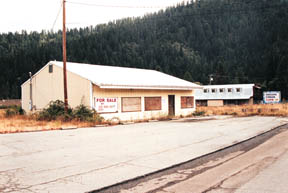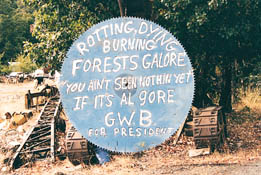|
|
|
| Subscriptions click here for 20% off! | E-Mail: info@rangemagazine.com |
 |
With their efforts to make an honest living thwarted, the residents remaining in Happy Camp wonder whatever happened to President Clinton’s promises to help their industry and preserve their way of life. | ||||||||||||
HAPPY CAMP AND THE ECO-PIOUSGlorified grasshoppers and languishing loggers.Story and photos by Barry R. Clausen |
|||||||||||||
 |
|||||||||||||
| The radical eco-elitist leadership, philanthropists who fund their
ultra-utopian dogma, and certain members of the media have formed
an unholy alliance. The obvious goal of this religious alliance
is to tear down the infrastructure of rural America and rebuild
it according to their beliefs. Many of these eco-faithful believe
they have transcended good stewardship and care for the environment
by worshipping nature as others worship God. They are now recruiting
clergymen and other religious leaders to do the same, asking them
to include in their sermons and prayers, spiritual blessings for
the forests. Which organizations encourage church leaders to become involved in the “Greening of the Pulpit?” Do naive church leaders realize what their involvement is costing their fellow Americans? On November 15, 1999 the Northern California Grantmakers and Environmental Grantmakers Association West hosted a “Special Briefing” at the Northern California Grantmakers Conference in San Francisco entitled “Religion and the Forests: Protecting our Natural World.” The program included three “religious” speakers from California: Fred Kruger, executive director of the Religious Campaign on Forest Conservation (RCFC), Santa Rosa; Connie Hanson, founder and director of Christians Caring for Creation of Los Angeles; and Barak Gale, Coalition on the Environment and Jewish Life, San Francisco. Kruger, who also claims to be a former manager for the Republican National Committee and advisor for the Clinton/ Gore Administration, stated his organization works in conjunction with White House staff members regarding parks and monument designations. “We were contacted by the White House to become involved with this issue. We get calls from the White House on major policy decisions. They called us on the 40 million acres [a monument designation]. Our response was, it ain’t enough.” The RCFC distributed documents at the meeting claiming to have “played an indispensable role in building this bridge between religious and environmental organizations.” A primary tool of the group in this effort has been its religious declaration on forests calling for an immediate end to all cutting of ancient and old growth forests, the end of commercial logging on public land, redirection of taxpayers’ subsidies into forest restoration jobs, and prayer in the search for wisdom by churches on the spiritual value of forests. “This declaration has been adopted by a wide variety of religious entities, including the American Baptist Churches, the Episcopal, and the Evangelical Lutheran Church in America,” the documents state. “A close variation on this declaration was also adopted by the National Council of Churches, which represents 104 denominations and approximately 50 million people.” The RCFC first flexed its political muscle in February 2000 with a lobby week in Washington, D.C. The event drew together 42 religious leaders from around the country and from a wide variety of denominations to speak with a common voice on forest issues. The group held a prayer breakfast with Secretary of the Interior Bruce Babbitt, and met directly with the Chief of the U.S. Forest Service, the Chief of Staff of the White House Council on Environmental Quality and over 100 senators and representatives. Connie Hanson stated during her presentation, “It is a proven fact that towns do better when the mills shut down.” Unknown to the meeting’s sponsors, Steve Jolley, a Northern California forester, was in attendance. Jolley asked Hanson, “What about the timber towns and the families affected by the shut-down of the mills?” Hanson’s response was a shock to Jolley (and the two other timber industry supporters in attendance) as she casually explained that money given to the loggers helps the town and gives the loggers an opportunity to further their education. Connie Hanson’s son, Chad, is the executive director of the Pasadena-based John Muir Project, which is “dedicated to ending the timber sales program in America’s forests,” as well as a National Director of the Sierra Club. We searched, but could not find the location in rural America where timber towns are doing better as a result of mill closures as Connie Hanson claims. The town of Happy Camp, Calif. is a good example of the reality. |
|||||||||||||
|
|||||||||||||
|
Driving into town, the first impression is that it has all but
been abandoned. Businesses have been boarded up. “For Sale” signs
hang on most of the homes and buildings. Even the local gas station
is closed and for sale as a result of the local timber mill’s
closing.
|
|||||||||||||
|
Copyright © 1998-2005 RANGE magazine For problems or questions regarding this site, please contact Dolphin Enterprises. last page update: 04.03.05 |
|||

